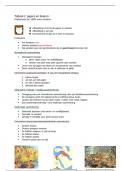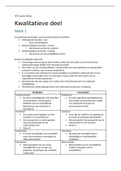Gender
,Sex and gender
Sex: BIOLOGICAL differences between males and females including
chromosomes, hormones and anatomy
Gender: The PSYCHOLOGICAL and cultural differences between males and
females including attitudes, behaviours and social roles
Sex vs gender
Sex Gender
❏ Innate ❏ Social construct
❏ Cannot be changed ❏ Open to change
❏ Result of nature ❏ Partly determined by nurture
❏ A person may become more
masculine/ feminine depending
on social context
,Sex and gender
Gender dysphoria
❏ When gender identity doesn’t match up with sex assigned at birth
❏ Gender reassignment surgery can occur because of gender dysphoria
Sex-role stereotypes: set of beliefs and preconceived ideas about what is
expected or appropriate for males or females in a society/ social group
❏ Can be communicated through reinforcement from parents, peers, media
and other institutions like schools
❏ Can lead to sexist assumptions
,Sex and gender
Review answers:
Review questions:
1. Sex is the biological differences between males
1. What is the difference between and females which includes chromosomes,
hormones and anatomy whereas gender is the
sex and gender? psychological differences between males and
females and includes attitudes, behaviours and
2. What are the features of sex? social roles
2. Innate, can be changed, result of nature
3. What are the features of 3. Social construct, open to change, partly
gender? determined by nurture, a person may become
more/ less masculine/ feminine depending on
4. What is gender dysphoria? social context
4. When gender identity doesn’t match up with sex
5. What are sex-role stereotypes assigned at birth
5. Set of beliefs and preconceived ideas about what
and what can it lead to? is appropriate for males/ females in society/
social group. It can lead to sexist assumptions
,Androgyny
Defining androgyny
❏ Androgyny: displaying a balance between masculine and feminine characteristics in one’s
personality
❏ Both males and females can be androgynous
❏ Overrepresentation of the opposite sex doesn’t qualify as androgynous
Androgynous
‘Everyday understanding’ ‘Within psychology’
To have the appearance of A personality type
someone who cannot be characterised by a balance
clearly identified as male or between masculine and
female feminine traits, attitudes and
behaviours
,Androgyny
Sandra Bem
❏ Developed a method for measuring androgyny
❏ High androgyny is associated with psychological wellbeing as having both masculine and feminine
characteristics makes a person better equipped to adapt to a range of situations
Measuring androgyny: The Bem Sex-Role Inventory (BSRI)
❏ Bem’s scale represents 20 typically male, 20 typically female and 20 neutral characteristics
❏ Respondents are required to rate themselves on a 7 point rating scale for each item (1- never true
for me, 7- always true for me)
❏ Scores are classified on 2 dimensions: masculinity-femininity and androgynous-undifferentiated
High masculine, Low feminine Masculine
High feminine, Low masculine Feminine
High masculine, High feminine Androgynous
Low feminine, Low masculine Undifferentiated
,Androgyny
Evaluation:
P People may not have insight on their gender
P Quantitative measure identity
E Useful for research purposes as data produced is
E Ratings on the questionnaire requires
numerical
understanding of one’s own gender identity,
Spence = there is more to gender identity than a set of which some may not have
typical behaviours of one gender
Gender is also a social construct therefore
= Qualitative methods offer a better way of analysing
gender
interpretations can vary between people unlike
sex which is a biological fact
One compromise = combine different scales e.g
Personal Attribute Questionnaire (PAQ) which adds Questionnaire rating is also subjective
another dimension called instrumentality and
expressivity to the masculinity-femininity dimension C BSRI may not be an objective and scientific
way of assessing gender identity
C Both quantitative and qualitative methods may be
useful in studying different aspects if gender identity
,Androgyny
Evaluation:
P The BSRI was developed over 40 years
P Appeared to be valid and reliable when the BSRI was
developed ago
E Scale was developed by asking 50 male and 50 E Behaviours classed as masculine or
female judges to rate 200 scales in terms of how much
the traits represented maleness and femaleness feminine may have changed significantly
Highest rated categories became the 20 male and 20 The BSRI is made up of stereotypical ideas
female characteristics on the BSRI
of masculine and feminine traits making it
The BSRI had validity because it was piloted on more outdated
than 1000 students and the results broadly
corresponded to the participant’s own description of
gender identity Pps were also from the US. These western
The BSRI had test retest reliability as a follow up
notions may not be the same in other
study was completed with a smaller sample of the cultures and countries
same students which produced similar scores 1 month
later C BSRI lacks temporal validity and
C There is reason to believe that the test was valid and generalisability
reliable
,Androgyny
Review questions (AO1): Review answers:
1. Displaying a balance between masculine and feminine
1. Define androgyny characteristics in one’s personality
2. Who can be androgynous? 2. Males and females
3. What doesn’t qualify as androgynous? 3. Overrepresentation of the opposite sex
4. A personality type characterised by a balance between masculine
4. What is the psychological understanding of androgyny
and feminine traits, attitudes and behaviours
5. Who developed a method for measuring androgyny? 5. Sandra Bem
6. What is high androgyny associated with? 6. Psychological wellbeing as having both masculine and feminine
7. What is the name of the method used to measure attributes makes a person better equipped to adapt to a range of
situations
androgyny? 7. The Bem Sex-Role Inventory (BSRI)
8. What does this method consist of? 8. 20 typically male, 20 typically female and 20 neutral characteristics,
9. What are the dimensions used to classify scores? respondents are required to rate themselves on a 7 point rating scale
10. What does high masculine, ,low feminine mean? (1 never, 7 always)
9. Masculinity-femininity and androgynous-undifferentiated
11. What does high feminine, low masculine mean? 10. Masculine
12. What does high masculine and high masculine mean? 11. Feminine
13. What does low feminine low feminine mean? 12. Androgynous
13. Undifferentiated
, Androgyny
Review answers:
Review questions (AO3):
1. Useful = data produced is numerical = Spence = there is
more to gender identity than a set of typical behaviours =
1. Outline the strength of measuring qualitative methods better = combination -> better
androgyny being a quantitative measure compromise = Personal Attribute Questionnaire =
2. Why is it an issue that people may not instrumentality and expressivity = both methods can be
helpful in different aspects of gender identity
have insight into their gender identity 2. Rating requires some understanding = gender = social
3. How did the BSRI appear to be valid and construct = views vary = subjective = may not be objective
and scientific
reliable?
3. 50 males and 50 females were asked to rate 200 scales =
4. Why is it an issue that the BSRI was highest rated made 20 categories on BSRI = piloted on
developed 40 years ago? >1000 students = results broadly corresponded to own
description = follow up study w/ smaller sample of same
students 1 month later = test retest reliability = reason to
beleieve it was valid
4. Typical behaviours have changed = ideas may be outdated
= US Pps to western ideas may not be the same in other
cultures = lacks temporal validity and generalisability










